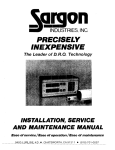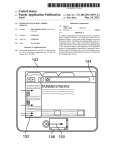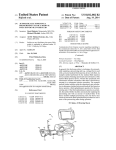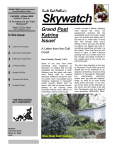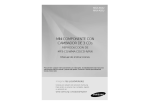Download Mobile microwave oven
Transcript
US 20020153370A1 (19) United States (12) Patent Application Publication (10) Pub. N0.: US 2002/0153370 A1 (43) Pub. Date: Stutman (54) MOBILE MICROWAVE OVEN (52) Oct. 24, 2002 US. Cl. .......................................... .. 219/715; 219/756 (76) Inventor: Peter S. Stutman, Sudbury, MA (US) (57) Correspondence Address: Peter S. Stutman 27 Lillian Avenue A mobile, loW poWered microwave oven is disclosed. The oven has top entry to the heating chamber, it is poWered Sudbury, MA 01776 (US) (21) Appl. No.: 09/751,893 (22) Dec‘ 29’ 2000 Flled: from the cigarette lighter, has the controls and display and the cooling vents also on the top surface of the oven. The oven is arranged to be secured to the seat by the seat belts in such a manner that the oven Will operate While so secured. Publication Classi?cation (51) There is also a spill container in the heating chamber. Materials may be used that make the oven cabinet transpar Int. Cl.7 ..................................................... .. H05B 6/80 410 80 200 ABSTRACT ent. / / ‘j 2%’ / \ 4 00 Patent Application Publication Oct. 24, 2002 Sheet 1 0f 10 US 2002/0153370 A1 4:2. at QQN Patent Application Publication Oct. 24, 2002 Sheet 2 0f 10 3 n u E) 2 1 M zS 4 5 6MODE US 2002/0153370 A1 STOP START 1AFig. Patent Application Publication Oct. 24, 2002 Sheet 3 0f 10 US 2002/0153370 A1 Patent Application Publication Oct. 24, 2002 Sheet 4 0f 10 160 Fig- 3 US 2002/0153370 A1 Patent Application Publication Oct. 24, 2002 Sheet 5 0f 10 zom?é .E US 2002/0153370 A1 f\ 2m5&5 >1$261 mm \‘ \ V m ® 6 < 0 5 > / z m o w c i n o w m 3mm am»_ 2. \ M omomm.U QEHQQ21#061@9$I‘l,. 3% 2 > % M20. < i w 5 PW.Q wm2w58m9m6 mm .m .mw__EjozIG!L .3 r .mt w Patent Application Publication L0 2: \ Oct. 24, 2002 Sheet 6 0f 10 US 2002/0153370 A1 120 \ 121 Fig. 5 Patent Application Publication Oct. 24, 2002 Sheet 7 0f 10 US 2002/0153370 A1 Fig. ,9; 5A Patent Application Publication Oct. 24, 2002 Sheet 8 0f 10 93 190 \ 190 I Fig. 6 US 2002/0153370 A1 Patent Application Publication Oct. 24, 2002 Sheet 9 0f 10 ‘f MOEWE ‘HICVQOWKAYJET 5 bit/‘55M’; ' 1 I 6 P5 RAT (m! Pd, 111L059 if , jaw/W1“ p 75235-10209 _1 US 2002/0153370 A1 Oct. 24, 2002 US 2002/0153370 A1 MOBILE MICROWAVE OVEN transparent microWave cavity liner designed to contain spilled foods and facilitate cleaning. Methods of retaining RELATED APPLICATIONS food containers Which hold the foods being heated, as Well as other safety and convenience features useful for real World operation in the mobile environment are described. [0001] The present application claims priority from US. Provisional Patent Application, entitled Mobile MicroWave Oven, Ser. No. 60/173,679, Which application Was ?led on Dec. 29, 1999, by Peter S. Stutman, a US. citiZen, of 27 Lillian Avenue, Sudbury, Mass., 01776 and Which provi sional is hereby incorporated herein by reference. FIELD OF THE INVENTION [0002] This invention generally relates to microWave [0006] It is envisioned that the device described Will ?nd Wide application in cars, trucks, recreational vehicles, boats and simple living situations Which do not provide conven tional AC mains and in Which consumers are unlikely to perform or have performed involved installations. It can be used for many tasks, from heating baby bottles and meals in properly designed containers, to heating the morning’s cof ovens and more speci?cally to microWave ovens for use in fee, to Warming automotive gasket materials in cold climates vehicles such as cars, trucks, and boats. It has features speci?c to operation from a standard DC poWer source found in such vehicles as Well as features Which mechani cally secure it Within the vehicle. during repair operations. [0007] In the preferred embodiment, a high frequency sWitching poWer supply generates the required ?lament and high voltage necessary for magnetron operation. This is BACKGROUND OF THE INVENTION more ef?cient than suffering DC/AC inverter losses in [0003] MicroWave ovens designed for portable operation and operation in vehicles have been proposed previously. poWer transformer. The magnetron is the type Whose mag US. Pat. No. 4,667,075 of Sakurai proposes using a three phase AC alternator to supply poWer. US. Pat. No. 5,276, 300 of LoW et al, describes a microWave oven containing essentially an inverter to alloW 12 volt DC operation. AGOR technologies of Verson, France manufactures a similar prod uct. These devices, operated at poWer levels of about 0.6-1.0 kW nominal require DC input currents from a 12 volt source of approximately 100 amperes. This much current requires direct connection to the vehicle battery With very heavy gauge Wire or the dedicated alternator of Sakai and implies mechanical and electrical installation skills beyond the range of the average consumer. The oven must also be somehoW mounted to the vehicle so that it does not move around. The microWave ovens previously described are mechanically very similar. They feature a cavity With a front opening door; that is, With a vertical hinge. The timer and control keypad is mounted vertically in proximity to the door and they are very similar to or modi?cations of conventional consumer microWave ovens. [0004] Conventional consumer microWave ovens have poWer ratings in the 500W-1000W range. These ratings represent the poWer delivered into the oven cavity. The nameplate poWer consumption of these microWave ovens is addition to the losses seen in the typical microWave oven netic ?eld is generated by permanent magnets. [0008] The only readily available electrical outlet or jack in most modem cars and trucks and smaller boats is the familiar “cigarette lighter” or “accessory poWer” socket. This socket is familiar to millions of users Who poWer mobile phones, radar detectors, small inverters and other convenience devices from them. These jacks are typically fused at 15-30 amperes. This limits total electrical poWer input to the microWave oven described here to a range of approximately 200-400 Watts. This corresponds to a typical microWave poWer rating of about 125-250 Watts. Most users of microWave ovens are used to larger poWer inputs as mentioned previously. Therefore the cooking time in this loW poWer microWave oven Will be longer than the “stan dard” times experienced in larger, more poWerful units. For example, if it takes 1 minute to heat a cup of soup to serving temperature in a 750 Watt microWave oven found in a typical American kitchen, it Will take three minutes nominally in a 250 Watt unit. In fact, given the signi?cant increase in cooking times, there Will be thermal losses including radia tional and convective losses Which Will tend to cool the food typically 50-75% higher. For example a Magic Chef being heated and Which Will lengthen the required time MC-03JS Compact MicroWave oven is rated at 500 Watts and is rated at a poWer consumption of 750 Watts. While these ovens could be poWered by a DC to AC inverter of beyond the simple ratio of poWer. In one mode the invention described here takes the “standard” cooking time for a 750-900 Watt microWave oven and automatically multiplies it by an appropriate factor to arrive at the correct heating appropriate output, the inverter Would have to be hardWired With heavy gauge Wire, such as No. 0, to the vehicle battery or alternator in order to receive the necessary current. If We assume a 90% inverter ef?ciency the 500 Watts oven men tioned above Would cause a typical inverter to draW a current of about 60 amperes at a nominal 13.8 volts. SUMMARY OF THE INVENTION [0005] This invention is a small, loW-poWer, approxi mately 200 Watt magnetron-type microWave oven. The invention described herein is designed to be poWered by a time for this loWer-poWer oven. In another mode the user enters a desired heating interval Which is not multiplied by any factor. [0009] The invention described herein also senses input current and voltage. It shuts doWn if excessive current is draWn to protect the “accessory socket’ fuse or if voltage drops to a level just above that Which corresponds to the vehicle battery being unable to start the vehicle. to be held in place on a seat by a standard vehicle seat-belt. [0010] A microWave oven, even a small one, is a substan tial mass, and it may contain foods Which are near or at the Also described is an upWard-opening door and plastic radio boiling point. It must be securely mounted Within the vehicle vehicle’s “accessory poWer” or “cigarette lighter” jack and Oct. 24, 2002 US 2002/0153370 A1 cockpit, such that in case of an emergency maneuver, sudden acceleration, or crash, it does not ?y about the cockpit seat of long vehicles While being plugged into the “cigarette lighter” or “accessory socket” Which is usually proXimal to causing injury or burn hazards to passengers nor damaging other components of the vehicle. The present invention has split loops affixed to the outside of the cabinet Which the vehicle’s front seat. facilitate securing the microWave oven in a seat With the seatbelt much as a child’s safety seat Would. In the event of a collision the microWave oven described here shuts doWn. [0016] [0017] FIG. 1A: Keypad for Mobile MicroWave Oven It also has the usual safety features such as door interlocks and over-temperature sensors found in virtually all con [0018] FIG. 2: Mobile MicroWave Oven Interior [0019] FIG. 3: Mobile MicroWave Oven Door, Door sumer microWave ovens. Conventional mounting points are Locking Solenoid, and Interlock provided for situations in Which the device may be bolted doWn. [0020] FIG. 4: Mobile MicroWave Oven System Diagram [0011] The invention described herein also places the intake and exhaust for the cooling air required by the magnetron on the top surface such that the airflow is not BRIEF DESCRIPTION OF THE DRAWINGS [0021] FIG. 1: Mobile MicroWave Oven FIG. 5: Inverted Pyramidal Food Retainer and Cavity Liner [0022] FIG. 5A: Food Container Retention Stud FIG. 6: VieW of Mobile MicroWave Oven in Seat impeded as it Would be if mounted on a seat With doWnWard [0023] or side facing intakes and exhausts. The keypad is also Retained by Seatbelt mounted on the top surface for easy access. [0024] FIG. 7: Side VieW of Mobile MicroWave Oven in Seat Retained by Seatbelt [0012] The invention described herein also has an upWard opening door alloWing access to the oven cavity. The cavity [0025] FIG. 8: Mobile MicroWave Oven Operational has a radio-transparent, removable, easily cleaned, plastic FloWchart liner made of heat resistant plastic Which contains any spills Which may occur. These tWo features help insure that even if food somehoW should spill Within the oven, that it Will not leak out into the vehicle cabin. The door is retained shut by a locking mechanism When the oven is in operation and may stay in that state until an unlock button is pushed on the unit’s keypad. [0013] Since the vehicle may be in motion While the invention is in use, means must be provided of ?xing the food container in place so that it does not “bounce around” and spill its contents nor damage the cavity Walls. In the preferred embodiment, a detented stud is centrally affixed to the center of the carousel. There are mating cavities molded into “microWave safe” plastic heating containers With lock ing lids and appropriate vents. The food is placed into the container, the vented lid is affixed With a latching lip or similar arrangement, and the cavity, typically in the center of the container is pressed doWn onto the detented stud Which retains it in place. Food portions in disposable heating containers, such as “Chef Boyardee® Lasagna, MicroWave Meals, (10.5 OZ. siZe)” can be manufactured With the appro priate mating cavity molded in. [0014] Alternatively an inverted pyramidal Well is molded into a radio-transparent, heat resistant plastic support sheet. Food in appropriate containers is placed doWn into the Well until contact is made With the Walls of the Well. Alternatively a curved non-metallic spring-loaded radio-transparent Wall could be used as retention device. [0015] A carrying handle is molded into the top surface to facilitate handling of the mobile microWave oven. A DC DETAILED DESCRIPTION OF DRAWINGS DESCRIPTION OF SYSTEM [0026] The LOW-POWER MOBILE MICROWAVE OVEN is typically placed on a passenger seat. On its top surface are the CONTROL KEYPAD AND DISPLAY (60), the magnetron COOLING AIR INTAKE (80) and OUTLET (110), and the upWard opening microWave CAVITY DOOR (160) af?Xed by HINGE (150). The HINGE (150) can be positioned on any of the four sides of the MICROWAVE CAVITY (120) opening in The door seals the cavity so as to contain all microWave energy by means of conductive elastomeric GASKET (210) and conventional choke seal design. [0027] The mobile microWave oven CABINET (200) is secured in place on the seat by running the seatbelt for that seat through the SPLIT LOOPS (190) attached to the CABI NET (200). The Waist portion of the seatbelt is tightened to secure the CABINET (200) in place. The SPLIT LOOPS (190) are angled doWn from the vertical plane toWard the seatback so as to facilitate force components acting on the CABINET (200) doWn toWard the seat cushion and back Ward toWard the seatback Without kinking or narroWing of the belt Where it passes through the SPLIT LOOPS (190). This method is similar to that used to secure infant and child safety seats in vehicles. Alternatively, angle brackets and screWs suitably attached to the CABINET (200) can be used to effect a permanent mounting. [0028] The “cigarette lighter” or “accessory poWer socket” PLUG (10) is inserted into the vehicle’s “CIGA RETTE LIGHTER” or “ACCESSORY” socket. A tWo conductor insulated POWER CABLE (15) of at least #8 gauge attached in series With the plug (10) brings poWer into the microWave oven’s cabinet (200). This positive lead of input cable terminated in a “cigarette lighter” plug or other suitable connector of sufficient length and sufficient gauge is this nominal 12 VDC poWer passes through the current provided so that the invention may be installed in the back sensing shunt (20) and is then bussed to the voltage regulator Oct. 24, 2002 US 2002/0153370 A1 (30), the input of the switching power supply (40), and the input of the Input voltage sensor comprised of A/D converter and the OVER TEMPERATURE SENSOR (175) and KEY STROKE DATA generated by CONTROL KEYPAD AND (70). It is also connected to the DC fan motor control sWitch DISPLAY (60). (95) and the door locking solenoid sWitch (185), and the [0033] Since this is a relatively loW-poWer microWave oven, heating times are longer than those of conventional, oven cavity lamp sWitch (125). The 12 VDC rating in a vehicle is nominal and is usually closer to 14 VDC When the vehicle engine is above idle speed [0029] The voltage regulator (30) is a simple series pass regulator Which outputs +5 VDC at suf?cient current to operate the system controller (50), the keypad/display (60) and associated components. Its devices have voltage ratings Which are suitable for use in the automotive electrical environment and Will survive the transients knoWn to eXist in this environment. [0030] The sWitching poWer supply (40) is an inverter type more poWerful microWave ovens typically found in kitch ens. The invention described here has poWer input to the cavity of approximately one fourth of the poWer found in typical kitchen microWave ovens. Most people Who use a microWave oven are familiar With “standard” heating times. These familiar times must be multiplied by a factor of approximately four in order to be correct for the loWer poWer level in this invention. If a “standard” heating time is entered via the CONTROL KEYPAD AND DISPLAY (60), the SYSTEM CONTROLLER (50) multiplies the time by four in order to Warm the food to the proper temperature. Since sWitching poWer supply With a 12 VDC nominal input. It outputs the magnetron ?lament poWer, typically about 3 longer intervals alloW more cooling by radiation and con vection, a manufacturer might adjust the time further With a lookup table or algorithm based on empirical results. A VDC at several amperes as Well as the B- voltage, typically about 2-4 kV and in this application about 75-100 mA at 2 surface pyrometer or other temperature sensor could also kV. The eXact voltages depend on the speci?c characteristics of the magnetron (100). The magnetron anode is typically grounded to the microWave oven case (200) and the cathode to anode potential necessary for operation is developed by depressing the isolated or “?oating” cathode ?lament beloW ground potential With the negative voltage. The magnetic ?eld of the magnetron is generated by permanent magnets integral With its housing. While magnetrons operating at the signal that desired temperature has been reached. [0034] The CONTROL KEYPAD AND DISPLAY (60) generates unique digital signals in a format suitable for input to the SYSTEM CONTROLLER (50), Whenever a key is pressed. This subsystem also contains display drivers Which cause symbols and digits to appear in the multi-segment multi-character alphanumeric display When appropriate data is received from the SYSTEM CONTROLLER (50). typical 2450 MHZ frequency have been used in a prototype DESCRIPTION OF OPERATION of this invention, other frequencies might be employed to optimiZe energy transfer into or energy modes in the micro [0035] Wave oven cavity. The sWitching poWer supply (40) utiliZes inductive transformers Whose Wire Windings, insulation and other mechanical construction produce satisfactory insula seat in a vehicle. The Waist belt portion of the seatbelt tion and isolation so that the magnetron (100) ?lament can The LoW-poWer microWave Oven is placed in a corresponding to that seat is passed through the SPLIT LOOPS (190). The Waist belt is tightened doWn to secure the CABINET (200) in the seat. be safely ?oated, and so that the high voltage output is not compromised. The 3 VAC output is electrically ?oating and connected With Wires With insulation of adequate voltage lighter” or “accessory poWer” socket of the vehicle in order rating. (30) regulates the 12 VDC input to +5 VDC required by the [0031] The sWitching poWer supply operates at a fre quency much higher than that of a typical AC line (60 HZ) and therefore requires less energy storage on the output. Consequently the poWer supply output can be keyed on and off very rapidly by means of the PS (PoWer Supply) ENABLE SIGNAL from the System Controller (50). In the preferred embodiment, the PoWer supply is driven by a PS (PoWer Supply) CLOCK generated in ?rmWare by the SYSTEM CONTROLLER (50), alternatively a separate clock signal generator could be used. [0032] The SYSTEM CONTROLLER (50) is a micropro cessor With associated RAM and ROM adequate for opera tion. PoWer is taken from VOLTAGE REGULATOR (30) Which also serves to isolate and decouple the SYSTEM CONTROLLER (50) and related components from tran sients that occur in vehicle poWer systems. Inputs to the SYSTEM CONTROLLER (50) are Input Voltage Reading; Vr output by A/D CONVERTER (70), Input Current Read ing, Ir, developed by CURRENT SHUNT (20) and A/D CONVERTER (75), the ACCELEROM signal output by ACCELEROMETER (300), LOGIC CLOCK output by CLOCK GENERATOR (350), INTERLOCK SIGNALS from the DOOR CLOSED INTERLOCK SWITCH (180) [0036] The PLUG (10) is inserted into the “cigarette to obtain 12 VDC poWer. The VOLTAGE REGULATOR SYSTEM CONTROLLER (50) and the CLOCK GENERA TOR (350). [0037] The DOOR (160) of the MICROWAVE CAVITY (120) sWings open on HINGE (150). The user places the food or other substance to be heated in a “microWave safe”, radio-transparent heating container With a locking vented lid. If the heating container has a mating recess molded into the bottom, the container can be “popped” onto the DETENTED RETAINER STUD (140). If there is no retain ing component on the heating container the PLASTIC LINER WITH INVERTED PYRAMIDAL WELL (145), is used. This component (145) made of radio-transparent, heat-resistant plastic, is simply placed in the microWave oven CAVITY (120) in place of the PLASTIC LINER (130). The food container described above is placed as far doWn into the Well as it Will go, thus retaining it in most situations. The DOOR (160) is closed, the SPRING LAT CHING PIN (175) is captured by the retaining RETAINING SPRING CATCH (170) and pressing on DOOR INTERLOCK SWITCH (180) Which closes, sending a logic level signal to the SYSTEM CONTROLLER (50). [0038] The user enters the length of time the food is to be heated. If the user presses “STANDARD” on the “CON Oct. 24, 2002 US 2002/0153370 A1 TROL KEYPAD AND DISPLAY(60)”, the SYSTEM CON other stationary CAVITY (120) Walls, enabling a conven TROLLER (50) multiplies by a factor Which compensates tional “front-opening” microWave oven With a vertical for the loW-poWer feature of this microwave oven. Typically HINGE (150). this factor Will be in the range of 2-6. If the user does not press the “STANDARD” key, the time entered not multi plied and represents the eXact heating time. What is claimed is: [0039] The user presses the “START” key on the CON TROL KEYPAD AND DISPLAY (60). The SYSTEM CON 1. A loW-poWer microWave oven capable of operating from the DC poWer normally available in passenger vehicles TROLLER (50) looks at all input signals after receiving the “START” signal. The folloWing signals must be present: [0040] INTERLOCKS: DOOR INTERLOCK SWITCH (180) actuated by closure of cavity DOOR (160) in series With OVER TEMPERATURE SEN SOR (175) Pulls “INTERLOCKS” line to ground. [0041] Vr: Voltage reading from A/D CONVERTER (70) must be above minimum Acceptable battery voltage, nominally 11.5 volts. [0042] Ir: Current reading from A/D CONVERTER (75) must be beloW maXimum current rating of poWer socket in vehicle. Set by manufacturer as a function of intended usage, nominally 15 amperes in a small car, as high as 30 amperes in some larger trucks. and boats through the “cigarette lighter” or “accessory poWer” socket and having means of using a seatbelt to secure the microWave oven in a seat of a vehicle, compris ing; A compact microWave oven cabinet enclosing a cavity or heating chamber, Whose Walls are constructed of a radio re?ecting material such as metal sheet, having a similarly constructed door alloWing access to the cav ity, a source of microWave energy, a magnetron, suit able for operation at the poWer levels described, receiv ing poWer at appropriate voltages from a sWitching poWer supply deriving its poWer from the vehicle “cigarette lighter” or “accessory poWer” socket. 2. Means for the microWave oven described in claim 1 With its control keypad and display, and cavity door, on the same top surface such that they may be easily accessed While the microWave is secured in a seat of a vehicle and so that [0043] If not all conditions are satis?ed, a “BEEP” com mand is sent to the pieZoelectric annunciator to inform the user. If all conditions are satis?ed the SYSTEM CON TROLLER (50) begins the heating of the food in its heating container. This is commanded by outputting the folloWing signals and causing the folloWing actions: [0044] PS ENABLE: This signal enables SWITCH ING POWER SUPPLY (40) operation. [0045] PS CLOCK: This signal drives the poWer sWitching circuits in the SWITCHING POWER SUPPLY (40) thus supplying ?lament voltage 3 VAC as Well as negative high voltage B- to the cathode food may be easily placed into, and removed from, the microWave oven cavity. Cooling air intake and outlet on the same top surface so they are not blocked, occluded, ,nor air?oW through them impeded, by proximity to the seat components or other structures. 3. The microWave oven described in claim 2 With a DC motor having af?Xed to its shaft a set of fan blades and positioned so as to intake air from a top surface mounted vent and plenum, propel the air through the magnetron anode cooling structure and then through an additional plenum out another top surface mounted vent. 4. The microWave oven described in claim 3 With a MAG FAN ON: This signal drives the sWitch voltage regulator alWays on When the device is connected to the vehicle poWer source, providing poWer at appropriate voltage for the various logic and control circuits. transistor (92) Which causes the DC FAN MOTOR to turn the attached FAN BLADES (85). This draWs air solenoid operated locking mechanism to prevent the cavity (?lament). [0046] 5. The microWave oven described in claim 4 With a in through top-mounted cooling air intake and cir culates it through the attached PLENUM (82) past the DC FAN MOTOR (90) through the MAGNE door from springing open While the vehicle is in motion and thus releasing microWave energy into the vehicle. TRON ANODE THERMAL RADIATOR (105) and detented stud, of retaining molded “microWave safe” food containers With locking lids and appropriate vents in place eXhausts it via PLENUM (112) through top-mounted COOLING AIR OUTLET (110). [0047] LOCKDOOR: This signal actuates the DOOR LOCK SOLENOID (390) by driving the sWitch transistor (395). [0048] After the inputted time interval has elapsed the SYSTEM CONTROLLER (50) ceases outputting all the signals necessary for the heating to occur and the DOOR (160) is unlocked. If any of the signals required by the SYSTEM CONTROLLER (50) are lost, (50) ceases output ting the signals required for heating to occur. [0049] The preferred embodiment described demonstrates the advantages of the invention. Variations on the embodi ment described can be made to accommodate different installation con?gurations. For eXample, the DETENTED RETAINER STUD (140) could be moved to one of the four 6. The microWave oven in claim 5 With a means, a While a vehicle is in motion by means of a mating cavity or other retaining structure molded in to the bottom of the food container. 7. The microWave oven in claim 6 With a removable molded, radio-transparent, heat-resistant, dishWasher-safe plastic liner constructed to ?t closely into the microWave oven cavity and covering the bottom eXcept for a clearance hole for the detented stud and extending most of the Way up the sides of the cavity, but open at the top. 8. The microWave oven in claim 7 With a different removable molded, radio-transparent, heat-resistant, dish Washer-safe plastic liner constructed to ?t closely into the microWave oven cavity and having an inverted pyramidal Well into Which food heating containers may be placed so as to be constrained from movement While the vehicle is in motion. Oct. 24, 2002 US 2002/0153370 A1 9. The microwave oven in claim 8 With a digital system controller consisting of a microprocessor, adequate RAM and ROM and input buffers and output drivers Which moni tors acceleration signals from an accelerometer or similar spatial displacement measuring devices as Well as cavity door and over temperature interlocks and other sensors related to safety concerns, and Which causes immediate system shutdoWn in the event of a haZardous or fault condition. 10. The microWave oven in claim 9 With an algorithm to multiply a “standard” heating time for a typical full-siZe 16. A loW-poWer mobile microWave oven for use in a vehicle or boat comprising; a cabinet enclosing a cavity or heating chamber, Whose Walls are constructed of radio re?ecting material such as metal sheet, and Wherein the cabinet contains a door that provides access to the heating chamber, controls for the oven, a control keypad and display, and air inlet and outlets, a magnetron for providing microWave energy to the heating chamber or cavity, kitchen microWave, and input to the system controller input via the control keypad, by a factor properly compensating for the loWer poWer output and consequent longer heating a sWitching poWer supply that supplies energy to the time required in this loWer-poWer microWave oven. a plug and cable from the “cigarette lighter” or “accessory poWer” socket or similar connector for supplying poWer to the sWitching poWer supply. 11. The microWave oven in claim 10 With a DC motor magnetron, driving a cooling fan for a magnetron supplied With poWer directly from the vehicle via a transistor sWitch and Whose intake and eXhaust air?oW is contained Within plenums 17. A loW-poWer mobile microWave oven for use in a vehicle such as a car, a boat, or an aircraft, Wherein the vented to the outside of the cabinet. vehicle contains seat belts, comprising; 12. The microWave oven in claim 11 With a means of a cabinet enclosing a cavity or heating chamber, Whose monitoring input voltage and input current to the system and Walls are constructed of a ’radio re?ecting material such as metal sheet, and Wherein the cabinet contains a causing system shutdoWn in the event that the vehicle battery voltage drops beloW an acceptable level or if the current being draWn rises near a level Which Will cause the vehicle poWer outlet fuse to bloW or Which is otherWise unacceptable. 13. The microWave oven in claim 12 With a carrying handle molded into the top surface or externally a?iXed thereto so as to not interfere With any other required func tions. 14. The microWave oven in claim 13 With an eXternal cabinet or housing constructed of a transparent or translu cent material Which alloWs vieWing of the internal compo nents and construction. 15. A loW-poWer mobile microWave oven for use in a vehicle or boat comprising; a cabinet enclosing a cavity or heating chamber, Whose Walls are constructed of a radio re?ecting material such as metal sheet, a magnetron for providing microWave energy to the heating chamber, a sWitching poWer supply that supplies energy to the magnetron, means for supplying poWer to the sWitching poWer supply, and Wherein the cabinet de?nes a top surface, Wherein the controls for the oven, a control keypad and display, the cooling air inlets and outlets and a door that provides access to the heating chamber or cavity are all provided on the top surface. door that provides access to the heating chamber, controls for the oven, a keypad and display, and air inlets and outlets, a magnetron for providing microWave energy to the heating chamber, a sWitching poWer supply that supplies energy to the magnetron, means for supplying poWer to the sWitching poWer supply, and means for securing the oven to a seat by the seat belts. 18. A loW-poWer mobile microWave oven for use in a vehicle or boat comprising; a cabinet enclosing a cavity or heating chamber, Whose Walls are constructed of radio re?ecting material such as metal sheet, and Wherein the cabinet contains a door that provides access to the heating chamber, controls for the oven, a control keypad and display, and air inlets and outlets, a magnetron for providing microWave energy to the heating chamber or cavity, a sWitching poWer supply that supplies energy to the magnetron, and means for supplying poWer to the sWitching poWer supply Wherein the total poWer consumption is less than 300 Watts.
















